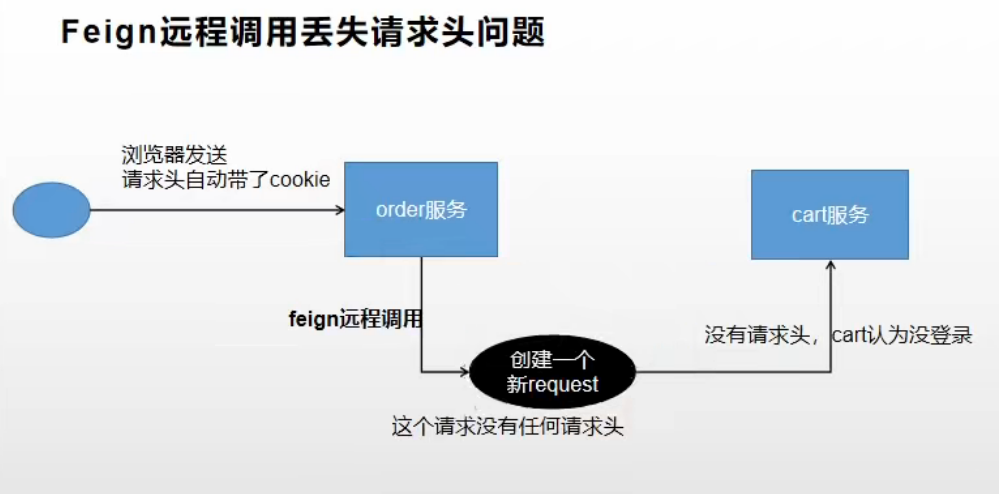一、 入门案例
1.1 引入依赖
<dependency><groupId>org.springframework.cloud</groupId><artifactId>spring-cloud-starter-openfeign</artifactId></dependency>
1.2 开启Feign客户端支持
在对应提供服务的项目启动类上使用此注解,开启feign支持。
@EnableDiscoveryClient// 示例@SpringBootApplication@EnableDiscoveryClientpublic class GulimallCouponApplication {public static void main(String[] args) {SpringApplication.run(GulimallCouponApplication.class, args);}}
1.3 声明调用接口
在需要远程调用的服务中,声明调用接口,使用注解@FeignClient指定被调用的服务名,接口方法的返回值及方法名入参都与被调用方法保持一致。同时,根据被调用的接口请求uri,拼接出远程调用的路径。
注意:
- 远程调用路径包含了被调用接口的完整路径。- 请求方式保持一致。(`@PostMapping`等)- 入参注解保持一致。(`@RequestBody`等)
调用方:
@FeignClient("gulimall-coupon")
public interface CouponFeignService {
@RequestMapping("/coupon/coupon/member/list")
R memberCoupons();
}
被调用方:
@RestController
@RequestMapping("coupon/coupon")
public class CouponController {
@Autowired
private CouponService couponService;
@RequestMapping("/member/list")
public R memberCoupons() {
CouponEntity couponEntity = new CouponEntity();
couponEntity.setCouponName("满1块减50");
return R.ok().put("coupons", Arrays.asList(couponEntity));
}
}
1.4 调用
注入调用接口即可使用。
@RestController
@RequestMapping("member/member")
public class MemberController {
@Autowired
private MemberService memberService;
@Autowired
CouponFeignService couponFeignService;
@RequestMapping("/coupons")
public R test() {
MemberEntity memberEntity = new MemberEntity();
memberEntity.setNickname("小明");
// 调用
R memberCoupons = couponFeignService.memberCoupons();
return R.ok().put("member", memberEntity).put("coupons", memberCoupons.get("coupons"));
}
}
二、问题解决
2.1 丢失请求头问题
2.1.1 远程调用丢失请求头
在Feign远程调用时,通过动态代理生成feign接口的实现类。
通过以下判断逻辑,过滤掉不需要远程调用的方法,再进行远程调用。
public class ReflectiveFeign extends Feign {
...
static class FeignInvocationHandler implements InvocationHandler {
private final Target target;
private final Map<Method, MethodHandler> dispatch;
FeignInvocationHandler(Target target, Map<Method, MethodHandler> dispatch) {
this.target = checkNotNull(target, "target");
this.dispatch = checkNotNull(dispatch, "dispatch for %s", target);
}
@Override
public Object invoke(Object proxy, Method method, Object[] args) throws Throwable {
// 下面的方法就不需要远程调用
if ("equals".equals(method.getName())) {
try {
Object otherHandler =
args.length > 0 && args[0] != null ? Proxy.getInvocationHandler(args[0]) : null;
return equals(otherHandler);
} catch (IllegalArgumentException e) {
return false;
}
} else if ("hashCode".equals(method.getName())) {
return hashCode();
} else if ("toString".equals(method.getName())) {
return toString();
}
// 若不是上边的方法,则获取当前方法来执行
return dispatch.get(method).invoke(args);
}
...
}
...
}
远程调用前,首先传入参数、创建对应的请求模板:
final class SynchronousMethodHandler implements MethodHandler {
@Override
public Object invoke(Object[] argv) throws Throwable {
// 传入参数,创建请求模板
RequestTemplate template = buildTemplateFromArgs.create(argv);
Retryer retryer = this.retryer.clone();
while (true) {
try {
// 获取模板,执行
return executeAndDecode(template);
} catch (RetryableException e) {
try {
retryer.continueOrPropagate(e);
} catch (RetryableException th) {
Throwable cause = th.getCause();
if (propagationPolicy == UNWRAP && cause != null) {
throw cause;
} else {
throw th;
}
}
if (logLevel != Logger.Level.NONE) {
logger.logRetry(metadata.configKey(), logLevel);
}
continue;
}
}
}
}
在下面的方法中,真正开始进行远程调用:
Object executeAndDecode(RequestTemplate template) throws Throwable {
// 生成请求实体
Request request = targetRequest(template);
if (logLevel != Logger.Level.NONE) {
logger.logRequest(metadata.configKey(), logLevel, request);
}
Response response;
long start = System.nanoTime();
try {
// 使用客户端发送请求
response = client.execute(request, options);
} catch (IOException e) {
if (logLevel != Logger.Level.NONE) {
logger.logIOException(metadata.configKey(), logLevel, e, elapsedTime(start));
}
throw errorExecuting(request, e);
}
...
}
在生成请求实体的方法中,获取拦截器,遍历进行模板的完善填充:
Request targetRequest(RequestTemplate template) {
// 遍历拦截器,修改模板
for (RequestInterceptor interceptor : requestInterceptors) {
interceptor.apply(template);
}
return target.apply(template);
}
远程调用时,请求丢失的原因分析:
feign调用的时候,创建了新的request对象,此对象中没有请求头在里边,所以丢失了前端携带过来的登录头信息。
我们可以通过构建feign内置的拦截器,来手动为创建的新request对象填充必要的登录头信息:
@Configuration
public class GuliFeignConfig {
@Bean("requestInterceptor")
public RequestInterceptor requestInterceptor() {
RequestInterceptor requestInterceptor = new RequestInterceptor() {
@Override
public void apply(RequestTemplate template) {
//1、使用RequestContextHolder拿到刚进来的请求数据
ServletRequestAttributes requestAttributes = (ServletRequestAttributes) RequestContextHolder.getRequestAttributes();
if (requestAttributes != null) {
//老请求
HttpServletRequest request = requestAttributes.getRequest();
if (request != null) {
//2、同步请求头的数据(主要是cookie)
//把老请求的cookie值放到新请求上来,进行一个同步
String cookie = request.getHeader("Cookie");
template.header("Cookie", cookie);
}
}
}
};
return requestInterceptor;
}
}
2.1.2 异步调用丢失请求头
在一个线程内部顺序执行多个远程调用逻辑的时候,可以通过拦截器在RequestContextHolder中正常的获取到当前线程内存储的请求属性信息。
为了提高效率,我们计划采用异步的方式同时远程调用去查询没有关联关系的数据:
/**
* 订单确认页返回需要用的数据
* @return
*/
@Override
public OrderConfirmVo confirmOrder() throws ExecutionException, InterruptedException {
//构建OrderConfirmVo
OrderConfirmVo confirmVo = new OrderConfirmVo();
//获取当前用户登录的信息
MemberResponseVo memberResponseVo = LoginUserInterceptor.loginUser.get();
//开启第一个异步任务
CompletableFuture<Void> addressFuture = CompletableFuture.runAsync(() -> {
//1、远程查询所有的收获地址列表
List<MemberAddressVo> address = memberFeignService.getAddress(memberResponseVo.getId());
confirmVo.setMemberAddressVos(address);
}, threadPoolExecutor);
//开启第二个异步任务
CompletableFuture<Void> cartInfoFuture = CompletableFuture.runAsync(() -> {
//2、远程查询购物车所有选中的购物项
List<OrderItemVo> currentCartItems = cartFeignService.getCurrentCartItems();
confirmVo.setItems(currentCartItems);
//feign在远程调用之前要构造请求,调用很多的拦截器
}, threadPoolExecutor).thenRunAsync(() -> {
List<OrderItemVo> items = confirmVo.getItems();
//获取全部商品的id
List<Long> skuIds = items.stream()
.map((itemVo -> itemVo.getSkuId()))
.collect(Collectors.toList());
//远程查询商品库存信息
R skuHasStock = wmsFeignService.getSkuHasStock(skuIds);
List<SkuStockVo> skuStockVos = skuHasStock.getData("data", new TypeReference<List<SkuStockVo>>() {});
if (skuStockVos != null && skuStockVos.size() > 0) {
//将skuStockVos集合转换为map
Map<Long, Boolean> skuHasStockMap = skuStockVos.stream().collect(Collectors.toMap(SkuStockVo::getSkuId, SkuStockVo::getHasStock));
confirmVo.setStocks(skuHasStockMap);
}
},threadPoolExecutor);
//3、查询用户积分
Integer integration = memberResponseVo.getIntegration();
confirmVo.setIntegration(integration);
//4、价格数据自动计算
//TODO 5、防重令牌(防止表单重复提交)
//为用户设置一个token,三十分钟过期时间(存在redis)
String token = UUID.randomUUID().toString().replace("-", "");
redisTemplate.opsForValue().set(USER_ORDER_TOKEN_PREFIX+memberResponseVo.getId(),token,30, TimeUnit.MINUTES);
confirmVo.setOrderToken(token);
// 当所有的异步任务都执行完成之后才放行
CompletableFuture.allOf(addressFuture,cartInfoFuture).get();
return confirmVo;
}
<br />这时候就会遇到新的问题,在异步的远程调用时,发现请求头又丢失了,这是因为我们在创建了新的线程之后进行远程调用,这时候feign的拦截器是在当前线程中获取ThreadLocal中的请求属性信息,这会导致一个问题,就是新线程在自己的ThreadLocal中无法获取到之前线程中的数据,导致传递到远程接口中的请求头里没有对应的登录信息。<br />
所以,我们需要在新开辟线程的时候,将老线程中的请求属性信息拷贝一份到新线程中,这样远程调用时就可以正确携带相关的登录数据抵达远程接口:
/**
* 订单确认页返回需要用的数据
* @return
*/
@Override
public OrderConfirmVo confirmOrder() throws ExecutionException, InterruptedException {
//构建OrderConfirmVo
OrderConfirmVo confirmVo = new OrderConfirmVo();
//获取当前用户登录的信息
MemberResponseVo memberResponseVo = LoginUserInterceptor.loginUser.get();
//获取当前线程请求头信息(解决Feign异步调用丢失请求头问题)
RequestAttributes requestAttributes = RequestContextHolder.getRequestAttributes();
//开启第一个异步任务
CompletableFuture<Void> addressFuture = CompletableFuture.runAsync(() -> {
//每一个线程都来共享之前的请求数据
RequestContextHolder.setRequestAttributes(requestAttributes);
//1、远程查询所有的收获地址列表
List<MemberAddressVo> address = memberFeignService.getAddress(memberResponseVo.getId());
confirmVo.setMemberAddressVos(address);
}, threadPoolExecutor);
//开启第二个异步任务
CompletableFuture<Void> cartInfoFuture = CompletableFuture.runAsync(() -> {
//每一个线程都来共享之前的请求数据
RequestContextHolder.setRequestAttributes(requestAttributes);
//2、远程查询购物车所有选中的购物项
List<OrderItemVo> currentCartItems = cartFeignService.getCurrentCartItems();
confirmVo.setItems(currentCartItems);
//feign在远程调用之前要构造请求,调用很多的拦截器
}, threadPoolExecutor).thenRunAsync(() -> {
List<OrderItemVo> items = confirmVo.getItems();
//获取全部商品的id
List<Long> skuIds = items.stream()
.map((itemVo -> itemVo.getSkuId()))
.collect(Collectors.toList());
//远程查询商品库存信息
R skuHasStock = wmsFeignService.getSkuHasStock(skuIds);
List<SkuStockVo> skuStockVos = skuHasStock.getData("data", new TypeReference<List<SkuStockVo>>() {});
if (skuStockVos != null && skuStockVos.size() > 0) {
//将skuStockVos集合转换为map
Map<Long, Boolean> skuHasStockMap = skuStockVos.stream().collect(Collectors.toMap(SkuStockVo::getSkuId, SkuStockVo::getHasStock));
confirmVo.setStocks(skuHasStockMap);
}
},threadPoolExecutor);
//3、查询用户积分
Integer integration = memberResponseVo.getIntegration();
confirmVo.setIntegration(integration);
//4、价格数据自动计算
//TODO 5、防重令牌(防止表单重复提交)
//为用户设置一个token,三十分钟过期时间(存在redis)
String token = UUID.randomUUID().toString().replace("-", "");
redisTemplate.opsForValue().set(USER_ORDER_TOKEN_PREFIX+memberResponseVo.getId(),token,30, TimeUnit.MINUTES);
confirmVo.setOrderToken(token);
CompletableFuture.allOf(addressFuture,cartInfoFuture).get();
return confirmVo;
}

